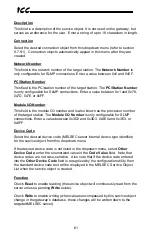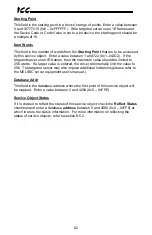
53
ICC
8.7.6
EtherNet/IP Server
The EtherNet/IP server driver allows the gateway to participate in I/O messaging
with other devices. It also supports the CSP server functionality without any
additional configuration. While the database start addresses at which the
produced and consumed data will map to are set via the configuration utility, the
sizes of these exchanged data packets are determined by the client upon initial
connection establishment.
To configure the EtherNet/IP server and the CSP server, click on the
Ethernet
Configuration
tab, check
EtherNet/IP Server
in the protocol dropdown menu to
enable the drivers, and then click on the
EtherNet/IP Server
subtab. This
section will discuss how to configure the EtherNet/IP server.
8.7.6.1
Configurable Fields
Device Name
The device name is used for identification of a device on the EtherNet/IP
network. This string is accessible as the “product name” attribute of the identity
object. Enter a string between 1 and 32 characters in length.
Run/Idle Flag Behavior
EtherNet/IP clients (such as PLCs) have the option of adding a 32-bit “run/idle”
header to all class 1 (I/O) data packets sent to devices. Bit 0 of this header is
called the “run/idle flag” by the EtherNet/IP specification, and is intended to
signify when the client is in a “running” state or an “idle” state. A running state
(run/idle flag = Run) is indicated whenever the client is performing its normal
processing (e.g. scanning its ladder logic). An idle state (run/idle flag = Idle) is
indicated otherwise. For example, Allen Bradley ControlLogix PLCs will set their
run/idle flag to Idle whenever their processor keyswitch is placed in the “PROG”
position, presumably in preparation to receive a new application program from
RSLogix.
The behavior of EtherNet/IP devices when they receive I/O data from a controller
with the run/idle flag set to Idle is not specified in the EtherNet/IP specification.
The gateway allows the option of two different behavioral responses when a
run/idle flag = Idle condition is received, depending on the state of the
Invoke
Timeout When Run/Idle Flag = Idle
checkbox.
•
If the checkbox is cleared (default setting), then the gateway will maintain the
last I/O data values received from the client. For example, if a device
mapped to the gateway was being commanded to run prior to the run/idle
flag being set to Idle, then it will continue to run.
•
If the checkbox is checked, then the gateway will invoke its user-configured
timeout processing (refer to section 8.3 for further details regarding timeout
processing). This setting allows the user to determine any gateway behavior
they may desire.
















































